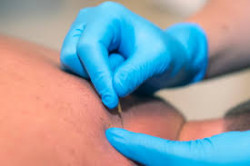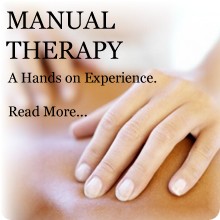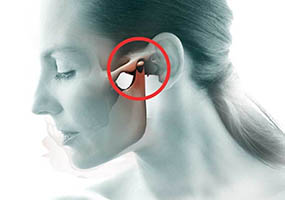Trigger Point Dry Needling
What is Trigger Point Dry Needling?
Trigger point dry needling (TPDN) is a treatment for muscular tightness and “spasm”, or "knots". These areas of tightness are commonly referred to as trigger points. Trigger points are defined as the presence of exquisite tenderness in a nodule of a taut band of muscle, and may elicit a twitch in response to pressure. Trigger points can develop from injuries, poor posture, or a disease process.
The muscular tightness or spasm that develops from an injury or disease process can cause compression and irritation of the nerves exiting the spine and anywhere along their pathway. When the nerves are irritated they can cause a protective “spasm” to any of the muscles along their pathway. Care must be directed both centrally to take care of the origin of the pain and peripherally to reduce symptoms from the central compression.
The technique uses small, thin, solid core filaments that get inserted into the muscles at the trigger points causing a replication of the pain or referral pattern. The muscles then contract and release. This contracting and releasing improves muscle flexibility, removes the source of irritation, promotes healing, and decreases the spontaneous electrical activity at the trigger points.
Cornerstone Physical Therapy has increased the level of knowledge of TPDN through the use of 3-Dimensional Cat Scans of the head, face and neck. Because of our interest and specialty focus our approach with TPDN is very in depth. The addition of diagnostic ultrasound to assess or "see" into the human body allows us a greater level of safety with TPDN. The Treatment for tinnitus patients as well as loss of speech and swallowing are some of the problems our clinic has been able to help, with the assistance of TPDN.
In the State of Colorado the requirements to practice TPDN are two weekend courses after 2 years of clinical experience. As the popularity of this technique grows more and more clinics are offering this treatment. Protect yourself by finding out how much training your Physical Therapist has undergone and how long they have been practicing. As with any treatment this should not be the only intervention that you receive by your Physical Therapist. TPDN can be a very safe technique in skilled hands.
If you are interested in this form of treatment and want to know more please call us at 719-596-5000.
Also to learn more about Trigger Point Dry Needling and to see a demonstration please click here 
Manual Therapy
 Cornerstone Physical Therapy sets itself apart by being a completely hands-on clinic. This is what manual therapy means, to diagnose and treat through the assessment of touch. This includes thrust manipulation to restore a “stuck” joint in your spine, to facilitating or helping a muscle work after a stroke. There are many different philosophies of manual therapy across the globe. At Cornerstone Physical Therapy we have been trained in many different treatment approaches. This allows us to have more “tools in our tool belt”. Because of our passion in our learning and our desire to excel in what we do we have continued to progress in manual therapy by certifying. A certification in manual therapy means that oral, practical and written tests were passed to achieve a higher level of practice. Many Physical Therapists practice some form of manual therapy, few specialize. When choosing a physical therapist, check their credentials. A specialist in a specific area can more effectively treat your condition.
Cornerstone Physical Therapy sets itself apart by being a completely hands-on clinic. This is what manual therapy means, to diagnose and treat through the assessment of touch. This includes thrust manipulation to restore a “stuck” joint in your spine, to facilitating or helping a muscle work after a stroke. There are many different philosophies of manual therapy across the globe. At Cornerstone Physical Therapy we have been trained in many different treatment approaches. This allows us to have more “tools in our tool belt”. Because of our passion in our learning and our desire to excel in what we do we have continued to progress in manual therapy by certifying. A certification in manual therapy means that oral, practical and written tests were passed to achieve a higher level of practice. Many Physical Therapists practice some form of manual therapy, few specialize. When choosing a physical therapist, check their credentials. A specialist in a specific area can more effectively treat your condition.
Headaches
 How can Physical Therapy help with headaches? Pain in the head, frequently called “Migraines”, can occur from many sources. The muscles of the jaw, neck and shoulders can refer pain into the head. The joints of the upper neck can also cause pain in the head. Issues with vision and even the vestibular or balance system can be a contributing factor. Diagnosing your headache can be difficult. If your headaches start in the base of the skull, are more one sided, occur frequently or even daily your headaches may be Tension Type or Cervicogenic Headaches. This means that the pain in your head is coming from tense muscles and/or stiff neck joints.
How can Physical Therapy help with headaches? Pain in the head, frequently called “Migraines”, can occur from many sources. The muscles of the jaw, neck and shoulders can refer pain into the head. The joints of the upper neck can also cause pain in the head. Issues with vision and even the vestibular or balance system can be a contributing factor. Diagnosing your headache can be difficult. If your headaches start in the base of the skull, are more one sided, occur frequently or even daily your headaches may be Tension Type or Cervicogenic Headaches. This means that the pain in your head is coming from tense muscles and/or stiff neck joints.
Physical Therapists specializing in treatment of the neck can determine if your headache is related. This can be treated with manual therapy, restoring joint motion and reducing muscle tension. Joel Rauser has lectured extensively on the role of headaches stemming from the neck and the successful treatment with manual therapy, and using dry needling at times. Other aspects that we assess are posture as well as work site analysis. A new form of vision therapy through restoring eye muscle balance is available at CornerStone Physical Therapy. We have treated people from all age groups, including children. Contact us if you have questions about whether your headaches are treatable with Physical Therapy.
For more information please visit

TMJ/TMD
 Temporomandibular Joint (TMJ) Disorders or TMD means that you have a problem with the hinge joints of the jaw. Diagnosis of a TMJ problem is difficult and books about the classification of TMJ disorders are usually fairly thick. TMJ issues can present with headaches, pain in the face, ear, neck and throat. They can feel like a pressure in your ear without any observable ear issues from your doctor. Patient’s will occasionally hear their pulse in their ear as well as ringing, called tinnitus. Balance issues and dizziness are common symptoms as well. Clicking in the jaw or noises in your ear with chewing or jaw motion are common but do not necessarily mean you have a problem needing treatment.
Temporomandibular Joint (TMJ) Disorders or TMD means that you have a problem with the hinge joints of the jaw. Diagnosis of a TMJ problem is difficult and books about the classification of TMJ disorders are usually fairly thick. TMJ issues can present with headaches, pain in the face, ear, neck and throat. They can feel like a pressure in your ear without any observable ear issues from your doctor. Patient’s will occasionally hear their pulse in their ear as well as ringing, called tinnitus. Balance issues and dizziness are common symptoms as well. Clicking in the jaw or noises in your ear with chewing or jaw motion are common but do not necessarily mean you have a problem needing treatment.
There are many forms of treatments for TMJ issues such as the use of a dental splint or appliance from your dentist. This is like putting on an ankle brace for an ankle sprain. A dental splint will change how your teeth together and hopefully reduce some of the stress of your jaw. Dental splints can also make your problem worse as well if not fitted appropriately or if there has not been a clear diagnosis made before the dental splint. A properly fitted dental splint requires a dentist to fabricate this for you. Over the counter splints rarely work. Other treatments are oral surgery. This is rare and should be used as a last resort.
The most cost effective and conservative treatment is through a Physical Therapist that specializes in the treatment of TMJ disorders. Physical Therapy training during school is very limited in the amount and quality of the information that we graduate with. Finding a Physical Therapist with a certification in TMJ Disorders is very important in your road to recovery. The University of St. Augustine and the American Academy of Orofacial Pain are the only schools that offer a certification to Physical Therapists regarding TMJ Disorders and the neck in the United States.
TMJ treatment is a multi-disciplinary approach and can include your doctor, pain specialists, dentists, pain psychologists, chiropractors and Physical Therapy.
If you'd like to learn more about TMJ Assessment please click
here.
Diagnostic Ultrasound







 Cornerstone Physical Therapy sets itself apart by being a completely hands-on clinic. This is what manual therapy means, to diagnose and treat through the assessment of touch. This includes thrust manipulation to restore a “stuck” joint in your spine, to facilitating or helping a muscle work after a stroke. There are many different philosophies of manual therapy across the globe. At Cornerstone Physical Therapy we have been trained in many different treatment approaches. This allows us to have more “tools in our tool belt”. Because of our passion in our learning and our desire to excel in what we do we have continued to progress in manual therapy by certifying. A certification in manual therapy means that oral, practical and written tests were passed to achieve a higher level of practice. Many Physical Therapists practice some form of manual therapy, few specialize. When choosing a physical therapist, check their credentials. A specialist in a specific area can more effectively treat your condition.
Cornerstone Physical Therapy sets itself apart by being a completely hands-on clinic. This is what manual therapy means, to diagnose and treat through the assessment of touch. This includes thrust manipulation to restore a “stuck” joint in your spine, to facilitating or helping a muscle work after a stroke. There are many different philosophies of manual therapy across the globe. At Cornerstone Physical Therapy we have been trained in many different treatment approaches. This allows us to have more “tools in our tool belt”. Because of our passion in our learning and our desire to excel in what we do we have continued to progress in manual therapy by certifying. A certification in manual therapy means that oral, practical and written tests were passed to achieve a higher level of practice. Many Physical Therapists practice some form of manual therapy, few specialize. When choosing a physical therapist, check their credentials. A specialist in a specific area can more effectively treat your condition. How can Physical Therapy help with headaches? Pain in the head, frequently called “Migraines”, can occur from many sources. The muscles of the jaw, neck and shoulders can refer pain into the head. The joints of the upper neck can also cause pain in the head. Issues with vision and even the vestibular or balance system can be a contributing factor. Diagnosing your headache can be difficult. If your headaches start in the base of the skull, are more one sided, occur frequently or even daily your headaches may be Tension Type or Cervicogenic Headaches. This means that the pain in your head is coming from tense muscles and/or stiff neck joints.
How can Physical Therapy help with headaches? Pain in the head, frequently called “Migraines”, can occur from many sources. The muscles of the jaw, neck and shoulders can refer pain into the head. The joints of the upper neck can also cause pain in the head. Issues with vision and even the vestibular or balance system can be a contributing factor. Diagnosing your headache can be difficult. If your headaches start in the base of the skull, are more one sided, occur frequently or even daily your headaches may be Tension Type or Cervicogenic Headaches. This means that the pain in your head is coming from tense muscles and/or stiff neck joints.



